Crafting Sophisticated Gin-Absinthe Cocktails
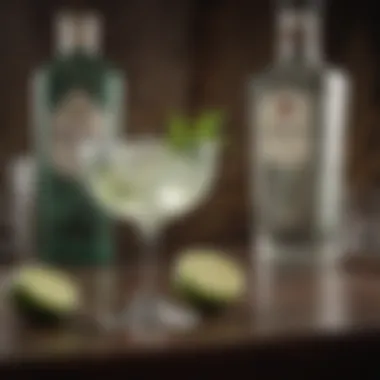

Intro
In the swirling, mystique-laden universe of mixology, gin and absinthe cocktails stand out like stars in a nocturnal sky. While many cocktails flirt with simplicity, merging two or three mainstream spirits, the combination of gin and absinthe brings forth a dazzling complexity. This fusion not only stirs the senses but also beckons the craft enthusiast to push the boundaries of traditional cocktail-making.
The marriage of bold and delicate flavors, paired with fascinating history, elevates gin-absinthe cocktails beyond mere beverages; they become a narrative of cultural influences and evolving palates. The purpose of this article is to peel back layers of this enchanting drink category. We will examine the rich history, delve into chosen ingredients, dissect preparation methods, and present unique combinations that reflect sophistication.
As we embark on this journey, keep in mind that a well-crafted gin-absinthe cocktail can serve as a delightful conversation starter at social gatherings or a cherished companion during quiet moments at home. With every sip, you're not just tasting a cocktail; you're taking a step back into time, exploring the dialogue between botanical infusions and herbal seductions.
Preamble to Gin-Absinthe Cocktails
The world of cocktails is a vast and colorful realm. Among the myriad combinations that awaken the palate and pique the imagination, gin-absinthe cocktails hold a unique spot, embodying both complexity and depth. It’s a combination that tantalizes, challenging traditional boundaries while inviting exploration. Understanding the nuances of this enigmatic duo can elevate one's mixology skills to new heights.
Defining the Gin-Absinthe Connection
Gin and absinthe, while distinct in their characteristics, share some key elements that make for a compelling cocktail experience. At first glance, one might view the two spirits as an odd pair, yet both are botanically infused, reflecting a deep appreciation for herbal nuances.
Gin is often celebrated for its diverse range of flavors, primarily derived from juniper berries, alongside numerous other botanicals like coriander, citrus peels, and spices. Each gin has its own story, variances that can create vastly different taste profiles ranging from earthy to floral.
On the contrary, absinthe, with its notorious history, is not merely a spirit; it is an elixir. It boasts anise as its predominant flavor, accompanied by wormwood and other herbs, which contribute to its unique and sometimes polarizing profile. The rich, green hue of absinthe often adds to the drama of the drink, while its high alcohol content packs a punch.
When blended together, gin and absinthe offer a cocktail experience rich in botanicals. They can enhance each other's unique qualities. For instance, the herbal notes of gin can harmonize with the anise flavors of absinthe, creating layers that beg for contemplation and enjoyment. It’s akin to how two different melodies can combine to form a richer, more intricate musical composition.
Significance in Modern Mixology
In the present day, mixology is not just about mixing drinks; it’s about storytelling and crafting experiences. The significance of gin-absinthe cocktails in this modern arena cannot be overstated. The complexity inherent in these cocktails affords bartenders the chance to showcase their skills, artistic tendencies, and innovative spirit.
Exploring this category of cocktails is akin to stepping into a laboratory of flavors. By playing with proportions and complementary ingredients—from vermouth to a dash of bitters—mixologists can create wide-ranging outcomes catering to different tastes and occasions. This experimentation fosters an environment rich in creative exploration.
The resurgence of classic cocktails in recent years has elevated the status of gin-absinthe concoctions, allowing enthusiasts to dive deeper into their flavor profiles. Bar menus across trendy spots often feature these drinks, complete with solo or signature spins, drawing in patrons eager to experience something beyond their comfort zones.
"The beauty of gin-absinthe cocktails lies in their complexity; they invite you to not just drink, but to contemplate each sip and savor the moments that come with it."
As modern palates evolve, there is a growing appreciation for the art of balance, which these cocktails exemplify splendidly: the refreshing brightness of gin juxtaposed with the darkly sweet elements of absinthe. By understanding and embracing this connection, one not only appreciates the intricacies of the gin-absinthe relationship but also gains insight into the broader cocktail landscape.
Historical Context
Understanding the historical context of gin-absinthe cocktails is like peering through a keyhole into a vibrant, often tumultuous past. Throughout the ages, both gin and absinthe have been steeped in rich traditions, cultural tales, and flavors that shaped not just how drinks were made, but also how they are perceived. This intricate backdrop serves as a foundation for modern mixology. The relevance of this section lies in the ability to connect modern palates with the stories and techniques of yesteryears.
Origins of Gin and Absinthe
The roots of gin reach back to the Middle Ages, with origins traceable to the Dutch's jenever, a juniper-infused spirit designed for medicinal use. Jenever found its way into English hearts by the 17th century, morphing into the classic gin we know today. Meanwhile, absinthe, often dubbed "the green fairy," was born in the late 18th century in Switzerland. Initially, it was concocted as a tonic before catching the fancy of artists and intellectuals in Paris in the 19th century.
The blooming popularity of absinthe resulted in its pivotal role during the Belle Époque, a period characterized by cultural flourishing in France. Artists like Vincent van Gogh and Oscar Wilde, drawn to its storied effects, raised a glass to creative inspiration, though this also led to significant controversy. Both spirits quickly became symbols of societal shifts and evolving tastes, influencing contemporary cocktail culture.
By tracing their origins, we can see how gin and absinthe are not simply beverages but vessels of history that shaped social interactions in taverns and salons.
Evolution of the Cocktail Culture
The cocktail culture has undergone tremendous transformations through different eras, and the cocktails that fuse gin and absinthe are no exception. The early 20th century bore witness to a cocktail renaissance, an era where balance and artistry in drink-making emerged prominently. Speakeasies thrived during Prohibition, and gin became the go-to base spirit due to its versatility and ability to mask lower-quality alcohol.
The post-Prohibition period saw a revival of classic cocktails that often blended gin with innovative ingredients, including absinthe. As bartenders experimented, drinks like the "Sazerac" and "Aviation" showcased the dynamic interplay between the two spirits, illustrating a sophisticated balance of flavors.
Moreover, contemporary mixology has embraced these historical influences, blending them with modern techniques and flavors. Conversations around sustainability, locality, and the revival of forgotten ingredients push forward an ever-evolving landscape of cocktail creativity.
Understanding these historical currents not only enhances our appreciation for gin-absinthe cocktails but also enriches our own drinking experiences, enabling us to savor each sip with an awareness of its past.
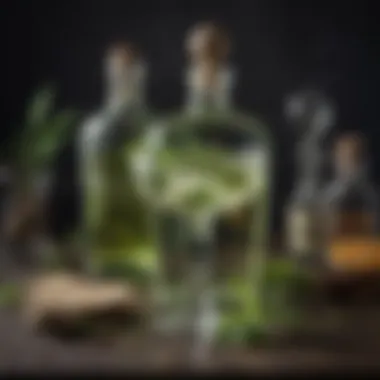

"Both gin and absinthe capture the essence of their times, serving as mirrors to societal trends, while each sip tells a story of its own."
As we venture deeper into the details of crafting gin-absinthe cocktails, remembering their origins and evaluations helps retain authenticity in our mixology endeavors. The past informs the present, allowing us to step into a legacy marked by experimentation and artistry.
Key Ingredients in Gin-Absinthe Cocktails
The realm of gin-absinthe cocktails hinges upon the quality and selection of key ingredients. Each component plays a pivotal role in crafting a drink that not only tantalizes the taste buds but also tells a story of flavors, tradition, and creativity. Using the right ingredients means more than just mixing; it’s about achieving balance and harmony, allowing the distinct characteristics of gin and absinthe to shine through. Readers should appreciate how these elements contribute to the overall experience of the cocktail, from the initial sip to the lingering aftertaste.
Understanding Gin Varieties
Gin is far from a one-size-fits-all spirit. Understanding the different varieties can enhance any gin-absinthe cocktail. Traditional London Dry gin brings a bold, juniper-forward profile, while a more contemporary craft gin might showcase floral or citrus notes. This allows for remarkable customization. The choice of gin can create entirely different drinking experiences, making it a crucial ingredient when you’re tinkering with recipes. Even within categories, nuances exist—think of a citrusy or herbaceous gin paired with a heavy anise-flavored absinthe.
Exploring Absinthe Types
Absinthe itself comes with its own rich tapestry of variety. The types differ significantly based on their botanicals, flavor profiles, and preparation methods. Some absinthes provide a strong anise flavor, while others might incorporate additional herbs or spices, leading to subtle differences in the final cocktail. Choosing the right absinthe can elevate the drink from simple to sublime, and knowing how different brands and styles interact with gin is valuable for any serious mixologist.
Complementary Ingredients
The world of gin-absinthe cocktails isn’t limited to just the spirits themselves. Complementary ingredients enhance the overall profile, adding layers of depth to the experience.
Bitters
Bitters are a small, often overlooked yet vital component in cocktail crafting. They bring complexity and balance that can be crucial in the gin-absinthe amalgamation. A few dashes of orange bitters, for example, can cut through the sweetness of the absinthe, allowing for a more harmonious drink. The bitter element contrasts nicely, facilitating a more rounded taste that isn’t overly sweet or overwhelming. Choosing the right bitters can decisively swing the balance of flavor and should match the specific gin and absinthe being used.
Syrups
Syrups add a touch of sweetness that can soften the more powerful botanical notes found in gin and absinthe. A simple syrup infused with lavender or even earl grey tea can enhance the aromatic qualities of a cocktail, lending it a softer texture and nuanced flavor. However, care is required; too much syrup can skew the drink towards saccharine, masked flavors, detracting from the herbal nature of the spirits. Using syrups judiciously can enhance rather than overwhelm.
Herbs and Botanicals
Incorporating fresh herbs and botanicals can elevate a cocktail to new heights. Herbs such as thyme or basil can complement the botanical undertones of gin while also interacting beautifully with the complex flavors of absinthe. Freshness provides a pleasant contrast, creating a lively palate experience. However, extracting too much bitterness from strong herbs could throw off the balance of the drink. Finding the right mix is part of the artistry, and being patient with experimentation is key.
"To compose a cocktail is to compose an experience, one sip at a time."
Through an understanding of these key ingredients, mixologists can transcend ordinary cocktails. Playing with various gin varieties, exploring absinthe types, and thoughtfully selecting complementary ingredients can make the difference between a forgettable drink and an unforgettable masterpiece.
Techniques for Crafting Gin-Absinthe Cocktails
Creating gin-absinthe cocktails requires more than just combining ingredients in a glass. The specific techniques involved play a pivotal role in achieving the desired flavor and presentation. Understanding these techniques can transform a basic drink into an extraordinary experience, enhancing not just the taste but also the visual pleasure. One might say it's where the alchemy of flavors meets the artistry of presentation.
Essential Mixing Techniques
Mixing is an art form, especially when it comes to gin and absinthe, where precision is key. The balance of flavors hinges on a few fundamental methods that any aspiring mixologist should grasp:
- Stirring vs. Shaking: While shaking combines ingredients vigorously, stirring is more suited for gin-based cocktails as it maintains the smooth profile without over-aerating. This method allows the botanicals in gin to mingle beautifully without losing their character.
- Free Pouring: Many bartenders favor free pouring, which can add a more "authentic" touch to cocktails. However, measuring tools should not be overlooked. The right jigger ensures that each spirits’ proportion complements the other.
- Muddling Techniques: When using fresh herbs or citrus, gentle muddling is essential. The goal is to release flavors without turning the ingredients into a puree, which can make the cocktail too overpowering.
Mastering these techniques not only improves the taste but also showcases the intricate relationship between gin and absinthe.
The Role of Garnishes
Garnishes are often an afterthought, but in gin-absinthe cocktails, they can serve as an essential flavor accent. A thoughtfully chosen garnish does more than beautify the drink; it can elevate the overall sensory experience. Consider these elements:
- Herbs and Citrus: Fresh herbs like basil or mint can enhance the herbal notes of absinthe, while a twist of lemon peel adds a zesty brightness. They encourage the drinker to engage with the aroma before the first sip.
- Edible Flowers: For a sophisticated touch, edible flowers not only add a pop of color but also introduce delicate flavors that can play off the botanicals in gin. Think of nasturtiums or violets as a way to create visual intrigue.
- Ice Obstruction: Some cocktails benefit from larger ice cubes as they dilute slowly, keeping the drink cold while retaining its integrity. Garnishing with a piece of ice crafted in unique shapes can also enhance visual appeal.
Ultimately, garnishes should complement, not overpower. Careful consideration of this element can lead to breathtaking presentations that leave a lasting impression.
Proper Layering Methods
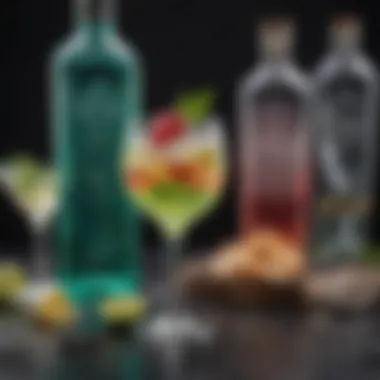
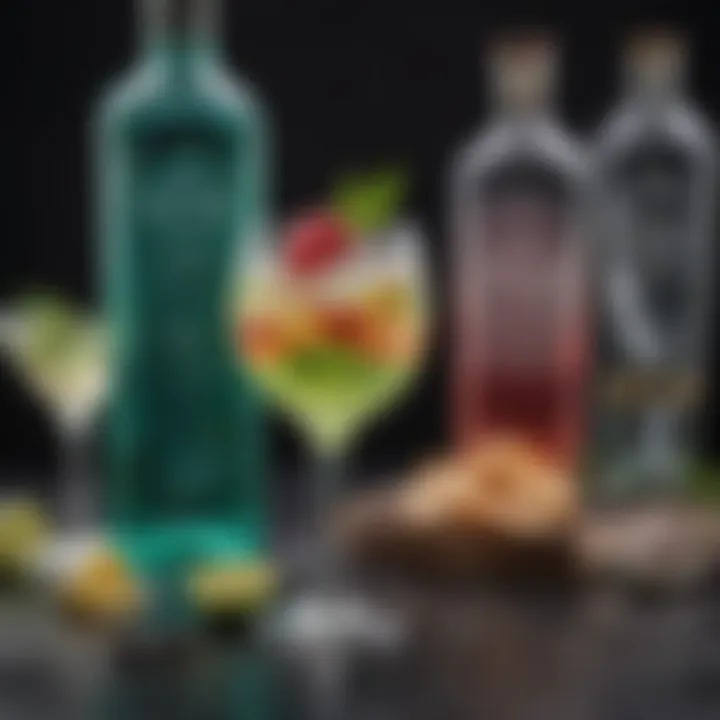
Layering is a technique that can create stunning visual effects in cocktails. With gin and absinthe, where one may want to highlight the different components, this method can be particularly effective. Here’s how to master layering:
- Understanding Density: Liquids have varying densities based on their sugar content, alcohol volume, and other factors. For example, absinthe is denser than most gins, allowing it to be poured slowly over the back of a spoon.
- Pour Method: Start with the denser liquid. When layering, a gentle approach is crucial. Utilizing the back of a spoon allows for a smooth transition from one layer to the next, maintaining separation between the spirits.
- Visual Dynamics: A well-layered cocktail invites curiosity, prompting the drinker to appreciate both appearance and flavor profile. By visually depicting the harmony or contrast between gin and absinthe, the drink becomes an experience unto itself.
As you experiment with these techniques, remember—they’re not merely procedural but an integral part of creating a memorable cocktail. Through thoughtful application, the complex flavors of gin and absinthe can be integratively showcased, resulting in drinks that are both visually striking and exquisitely balanced.
Flavor Profiles in Gin-Absinthe Cocktails
In the intricate world of gin-absinthe cocktails, flavor profiles play a crucial role, acting as the backbone that shapes the overall experience of the drink. Understanding the delicate balance between the botanicals in gin and the distinct anise flavor of absinthe is vital for crafting a cocktail that not only tastes delightful but also tells a story through its components. One might think of this interplay as a symphony; each ingredient, much like an instrument, has its part to play, contributing to the harmonious blend that keeps the drinker coming back for more.
Balancing Botanicals and Anise
Balancing the myriad botanicals found in different gin varieties with the bold, powerful anise of absinthe is no easy task. The distinct flavors of gin can range from herbal and floral to citrusy and spice-laden, influenced by the specific blend of botanicals used by each distiller. When paired with the sweetness and licorice notes of absinthe, achieving this balance is essential.
For instance, a gin that boasts notes of juniper and coriander might play exceptionally well with a smooth absinthe, creating a cocktail that teases the palate. However, if one uses a more robust and spiced gin, it might overshadow the subtler qualities of the absinthe. This attention to balance not only enhances the cocktail’s flavor but also provides a fuller drinking experience. Knowing how to measure and mix these flavors allows the bartender or home mixologist to deliver a drink that resonates with complexity and finesse.
Contrast and Complementarity
The interplay of contrasting flavors adds depth and intrigue to gin-absinthe cocktails. This concept revolves around not only recognizing how flavors complement each other but also how they can create a pleasant tension on the palate. Combining a very aromatic gin with a slightly bitter absinthe can yield a surprising yet satisfying dynamic.
For example, a floral-infused gin can offer aromatic notes that lighten the heavy anise aspect of absinthe. This is particularly effective when a touch of acidic elements, like citrus or even vermouth, is introduced into the mix. These contrasts—between the sweet, bold character of the absinthe and the light, fragrant botanicals of the gin—create a cocktail that tantalizes the taste buds.
Moreover, the exploration of complementary flavors can be enhanced by including additional modifiers like bitters, syrups, or botanicals, which can bridge the gap between the two spirits. This way, a cocktail can strike an ideal note that keeps drinkers engaged through each sip.
Seasonal Considerations
The season can significantly affect how flavors are perceived and enjoyed in cocktails. Seasonal ingredients can introduce freshness and vibrancy, or warmth and richness, making the drink experience much more engaging. For instance, lighter, herbal gins and refreshing absinthes are perfect for summer cocktails, perhaps complemented by fresh cucumber or mint.
In contrast, as the days grow shorter and colder, the inclusion of spices or darker, richer gins can elevate the experience. Ingredients such as cardamom, cloves, or even a splash of honey can enhance the comforting qualities of a gin-absinthe cocktail. Seasonal fruits like cranberries or citrus during colder months can also add an interesting layer of flavor, reflecting the time of year and keeping the drinkers intrigued.
By considering how seasonal changes impact flavor, mixologists can create drinks that not only taste great but also feel timely and relevant. Ultimately, the understanding of flavor profiles in gin-absinthe cocktails enriches the enjoyment of the drink and invites a deeper exploration into its complexities.
Signature Gin-Absinthe Cocktails
Gin-absinthe cocktails stand out in the realm of mixed drinks due to their intricate layers of flavor and historical significance. This section aims to unravel the essentials of signature cocktails that effortlessly blend these two distinct spirits. These cocktails not only serve as a testament to cocktail culture but also encapsulate a craft that invites creative exploration. The interplay of gin's diverse botanicals with absinthe's herbal, anise-forward profile leads to unique taste experiences that both challenge and delight the palate.
Classic Recipes Revisited
When it comes to classic gin-absinthe cocktails, a few iconic concoctions have stood the test of time. Familiar names, like the Sazerac or the Corpse Reviver #2, bring a sense of history and nostalgia to any bar menu. The beauty of these classic recipes lies in their simplicity and the balance of flavors they offer.
- Sazerac: Originating from New Orleans, this cocktail combines rye whiskey, a sugar cube, Peychaud's bitters, and a rinse of absinthe to create a strong yet flavorful drink that is as rich in history as it is in taste.
- Corpse Reviver #2: This delightful mixture combines gin with triple sec, Lillet blanc, lemon juice, and a hint of absinthe, making it a refreshing choice often considered a hangover remedy.
Altering these timeless recipes slightly can lead to exciting variations. For instance, using a London dry gin with a more herbal absinthe like Pernod might yield a drink that’s both familiar and novel, appealing to a broad range of gin enthusiasts.
Innovative Modern Creations
As mixology continues to evolve, bartenders are using gin and absinthe in unexpected ways. Innovative modern creations often take inspiration from various cultural influences, reshaping how we perceive these spirits. Consider a cocktail that fuses local ingredients and modern techniques:
- Mediterranean Revival: Featuring a floral gin blended with fresh basil, lemon zest, and a moderate dose of absinthe, this cocktail offers a fresh take, uplifting the traditional elements and introducing new sensations to the drinker.
- Midnight Elixir: An experimental mix combining navy-strength gin, activated charcoal for that intriguing look, and a splash of absinthe might surprise anyone seeking to push their tasting limits.
Each of these creative cocktails demonstrates how the classics can inspire boundary-pushing innovations, enticing both seasoned cocktail sippers and adventurous newcomers. By foregrounding seasonality and sustainability in ingredient sourcing, these signatures forge not only a personalized bar experience but also reinforce the importance of craftsmanship in cocktail creation.
“Cocktail creation is not simply about mixing alcohol but about curating a sensory experience.”
Presentation and Serving Suggestions
In the realm of mixology, presentation holds a hefty weight. It's the finishing touch that takes a cocktail from average to extraordinary. When it comes to gin-absinthe cocktails, how they are served can enhance the drinking experience. A well-presented drink not only entices the eye but also plays a role in the overall enjoyment of the flavors.
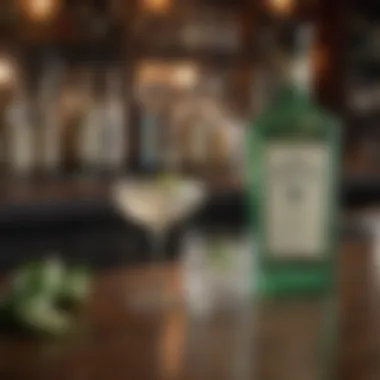

Glassware Choices
Choosing the right glassware can make a world of difference. For gin-absinthe cocktails, options vary depending on the desired aesthetic and functional requirements.
- Coupé Glasses: Traditionally used for serving cocktails, these offer a vintage feel and are perfect for showcasing the colors and textures of the drink.
- Nick & Nora Glasses: These have a slight curve and can heighten the aroma, making them a great choice for herb-infused cocktails.
- Old Fashioned Glasses: Ideal for cocktails served on the rocks, they give a more casual vibe while allowing the drink's flavors to shine through.
Ultimately, the choice of glass should be made with both the cocktail's character and the occasion in mind.
Ice Selection and Temperature Control
Ice isn't just a filler; it plays a pivotal role in shaping the drinking experience. Here are some elements worth considering:
- Quality and Type: Clear ice cubes have a visual appeal that ordinary ice lacks. They melt slower, keeping your drink colder for longer without dilution.
- Temperature: A chilled glass can do wonders. Chill glasses beforehand by placing them in the freezer or filling them with ice water for a few minutes.
- Crushed vs. Cubed: The texture of the ice can influence the cocktail's mouthfeel. Crushed ice is excellent for layered drinks, while cubed ice often works better for stirred cocktails.
Maintaining the right temperature without over-diluting is crucial for preserving flavor integrity.
Creating a Cohesive Bar Experience
The setting can influence how the cocktail is perceived. A cohesive bar experience can elevate the overall enjoyment tremendously. Here’s how to create that:
- Atmosphere: A dimly-lit space with appropriate music can set the mood. Consider soft jazz or ambient tunes for a more relaxed setting.
- Themed Serving: If you're serving a particularly herbaceous gin-absinthe cocktail, think about incorporating botanicals in the decor. Fresh herbs in small vases can bring the drink's flavor profile into visual play.
- Engagement: Share the story behind the cocktail. Customers love to hear about the history or inspiration. It makes the drink feel special and can spark conversations.
Cultural Impact of Gin-Absinthe Cocktails
The intertwining of gin and absinthe within cocktail culture paints a vibrant picture of both history and modernity. These cocktails not only serve as fascinating drinks but as cultural artifacts that challenge and reframe ideas about taste, creativity, and craftsmanship. In this section, we will explore how gin-absinthe cocktails have influenced various art forms and reflect current social trends, making them a noteworthy subject in today’s mixology discourse.
Gin and Absinthe in Literature and Art
Both gin and absinthe have loomed large in the works of poets, painters, and writers for centuries. They represent more than mere spirits; they are symbols of passion, rebellion, and artistic exploration.
In the 19th century, absinthe was often dubbed "the green fairy" and became the muse for several artists like Vincent van Gogh and Henri Toulouse-Lautrec. The drink's vibrant green hue distinctively captured the imagination and yet, also heralded the artists' struggles with addiction and societal rejection.
Gin, on the other hand, laid its roots deep within the fabric of London’s social scene during the Gin Craze of the 18th century. It was regarded as both a popular fixture in taverns and a symbol of the challenges faced by the urban poor. Literature from that era, like William Hogarth’s Gin Lane, depicts the moral decay associated with excessive drinking.
Today, references to gin-absinthe cocktails can be found in contemporary literature, often situated in narratives around nostalgia or enlightenment. Here are a few ways in which these spirits penetrate art and literature:
- Inspiration for Themes: Poets and novelists draw from the emotional landscapes painted by these spirits. Their deep-rooted connection to human experience creates a rich tapestry for storytelling.
- Visual Representation: Artists often evoke the essence of these spirits visually. The colors and textures of cocktails serve as a canvas for their own emotions and insights.
- Cultural Symbolism: Both gin and absinthe have transformed into cultural symbols that represent the duality of indulgence and sophistication. They highlight the complexities of human experience.
"Absinthe is the muse of the restless; it stirs the soul yet softly whispers the bittersweet truths of existence."
Modern Trends and Their Influences
In today’s rapidly evolving cocktail scene, gin-absinthe cocktails have surged in popularity, influenced by craft cocktail movements and new consumer preferences. Modern drinkers are increasingly drawn to cocktails that not only taste good but tell a story.
Several trends are significantly shaping the cultural landscape surrounding these drinks:
- Artisanal Crafting: Bartenders take pride in creating premium gin-absinthe cocktails, often sourcing local ingredients or infusing spirits to develop unique flavors. This dedication elevates the cocktail to an art form.
- Sustainability: With a greater awareness of sustainable practices, many mixologists are combining gin and absinthe with organic and locally-sourced botanicals, promoting both health and the environment.
- Cocktail Festivals: Events celebrating gin-absinthe cocktails have become hotspots for enthusiasts. They provide a platform for sharing knowledge, techniques, and rare spirits, further anchoring these cocktails in contemporary culture.
- Social Media Influence: Platforms like Instagram have nurtured a visually-driven cocktail culture, with stunning images of gin-absinthe cocktails flooding feeds. This has created a new kind of demand, focused not only on taste but presentation.
The cultural impact of gin-absinthe cocktails encapsulates a spectrum of emotions, historical contexts, and modern-day innovations. They invite drinkers to indulge in creativity, rethinking their consumption not just as a beverage but as a multifaceted experience.
As we embrace the evolving trends in mixology, it becomes clear that these cocktails will continue to reflect societal shifts and artistic endeavors for years to come.
Closure
As we draw the curtain on our exploration of gin-absinthe cocktails, it becomes clear that these drinks are not merely concoctions but intricate stories waiting to be told. In the realm of mixology, such cocktails stand as a testament to creativity, blending the time-honored traditions of gin with the enigmatic allure of absinthe. A drink like this shapes the very essence of social interaction, serving not just to flavor our gatherings but to enrich them with history and culture.
Reflecting on the Experience
Reflecting upon the journey into gin-absinthe cocktails allows us to appreciate the subtleties embedded in each sip. Gin, with its myriad of botanicals, dances seamlessly with absinthe’s strong anise notes, providing a unique tasting experience. For instance, a well-crafted Sazerac showcases this harmony, bridging the past with modern palate preferences. Each cocktail can also tell the drinker's own story, inviting discussion and shared memories. They become a conversation piece, not just at the bar but at home as we experiment with flavors and techniques.
Encouraging Exploration and Experimentation
Encouraging exploration and experimentation in the realm of gin-absinthe cocktails can lead to personal revelations in flavor and technique. The beauty of mixing these spirits lies in their versatility. One might start with a classic recipe but feel emboldened to add fresh herbs, unique bitters, or even new garnishes, leading to discoveries that may surprise and delight. Take the journey beyond recipes; let your palate lead the way. Consider hosting casual tasting evenings with friends, where each person attempts to concoct their own spin on gin-absinthe cocktails. This playful experimentation fosters not just skill but camaraderie.
"Mixology is an art form. It’s not about sticking to the rules, but about creating magic in a glass—one sip at a time."







